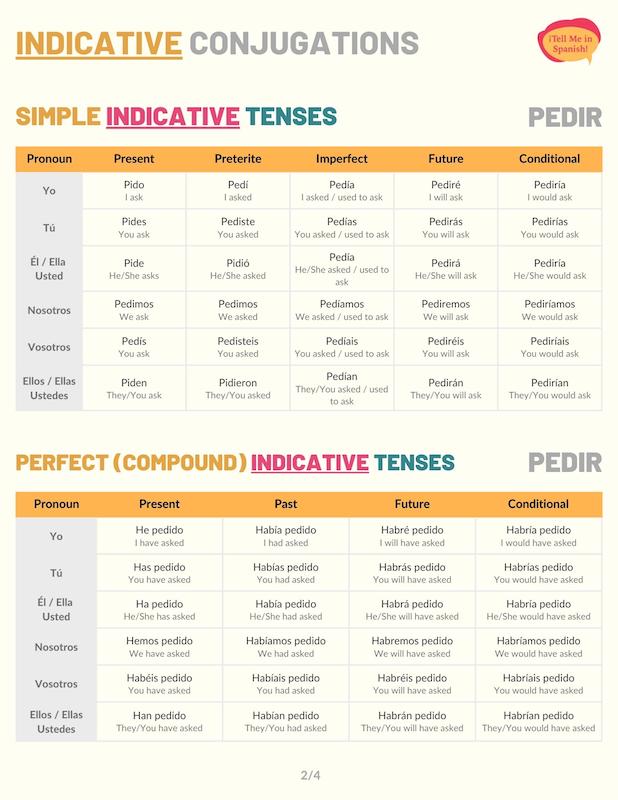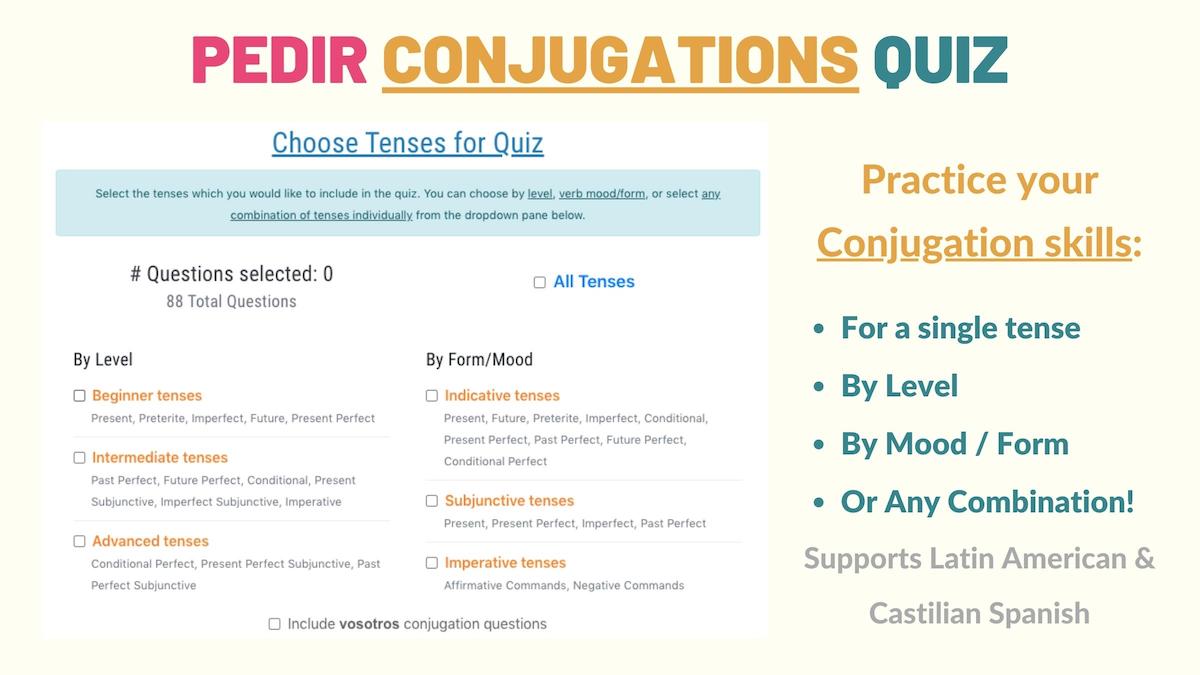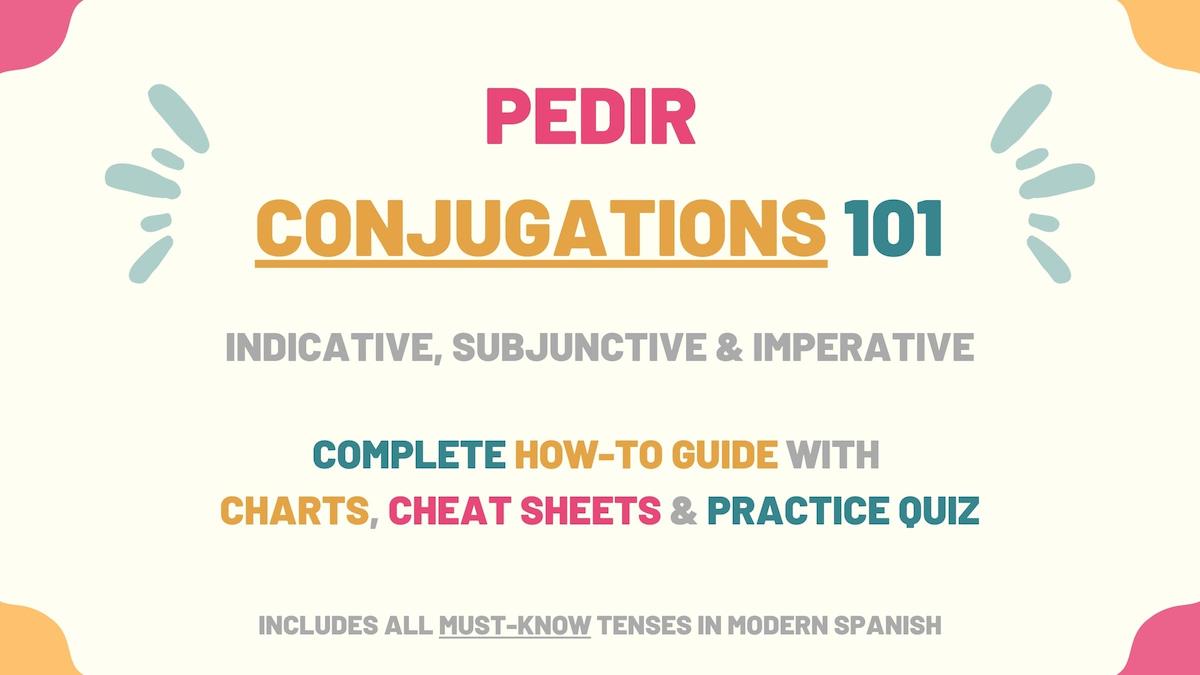Pedir is one of the most common verbs with E to I stem changes. Given that it’s a basic verb that can help you practice the -IR conjugation model and stem changes, in this article, you’ll learn the pedir conjugation patterns. Here is a summary of what we’ll cover:
- Pedir Overview
- Indicative Tenses of Pedir Conjugations
- Subjunctive Tenses of Pedir Conjugations
- Imperative (Commands) of Pedir Conjugations
- Uses & Examples
- Download Pedir Conjugation Tables & Uses Cheat sheets
- Pedir Conjugation Practice Quiz
Overview of Pedir
| Verb Characteristic | Property |
|---|---|
| Verb Type | -IR |
| Irregular | No |
| Infinitive | Pedir |
| Gerund (Present Participle) Form | Pidiendo |
| Past Participle Form | Pedido |
| Synonyms | Solicitar, requerir, exigir. |
Stem Changes: E to I
- Present Indicative: pid for all subject pronouns except ‘nosotros’ and ‘vosotros’.
- Preterite: pid for the third person singular and plural.
- Present Subjunctive: pid for all subject pronouns.
- Imperfect Subjunctive: pidie for all subject pronouns.
- Affirmative Imperative: pid for all subject pronouns except ‘vosotros’.
- Negative Imperative: pid for all subject pronouns.
In Spanish, the verb pedir is related to requesting something. However, it can have different translations and meanings. The pedir conjugation charts below only have one translation to keep these tables as organized as possible. Check the section Uses & Meanings to learn its other applications.
Indicative Conjugations of Pedir
Present tense
Pedir present tense conjugations have an E to I stem change. However, this change is not applied to ‘nosotros’ or ‘vosotros’. Conjugate pedir to the present tense to talk about the things people currently order or ask. For example: Yo siempre pido mi café con leche.
| Person | Conjugation | Translation |
|---|---|---|
| Yo | Pido | I ask |
| Tú | Pides | You ask |
| Él / Ella Usted | Pide | He/She asks You (formal) ask |
| Nosotros | Pedimos | We ask |
| Vosotros | Pedís | You ask |
| Ellos / Ellas Ustedes | Piden | They ask You (plural) ask |
Preterite tense
Pedir preterite conjugations have an E to I stem change only for the third person singular and plural. You can see these changes in the conjugation chart below. In the past preterite tense, this verb is used to talk about the things people ordered or asked at a specific moment in the past.
For instance: ¿Por qué me pediste mi teléfono?
| Person | Conjugation | Translation |
|---|---|---|
| Yo | Pedí | I asked |
| Tú | Pediste | You asked |
| Él / Ella Usted | Pidió | He/She asked You (formal) asked |
| Nosotros | Pedimos | We asked |
| Vosotros | Pedisteis | You asked |
| Ellos / Ellas Ustedes | Pidieron | They asked You (plural) asked |
Imperfect tense
When conjugated to the Spanish past imperfect indicative tense, pedir does not have any stem changes. We use pedir’s imperfect conjugations to refer to things people used to ask or order for an extended period of time in the past. Mis hermanos siempre me pedían ayuda.
| Person | Conjugation | Translation |
|---|---|---|
| Yo | Pedía | I asked I used to ask |
| Tú | Pedías | You asked You used to ask |
| Él / Ella Usted | Pedía | He/She asked He/She used to ask You (formal) asked You (formal) used to ask |
| Nosotros | Pedíamos | We asked We used to ask |
| Vosotros | Pedíais | You asked You used to ask |
| Ellos / Ellas Ustedes | Pedían | They asked They used to ask You (plural) You (plural) used to ask |
Near future
Ir (present tense) + a + infinitive (in this case, ‘pedir’) is the formula to conjugate the Spanish near future. Use these conjugations of ‘pedir’ to express that a person is going to ask or order something soon in the immediate future. Al rato, les voy a pedir que me ayuden.
| Person | Conjugation | Translation |
|---|---|---|
| Yo | Voy a pedir | I’m going to ask |
| Tú | Vas a pedir | You’re going to ask |
| Él / Ella Usted | Va a pedir | He/She is going to ask You (formal) are going to ask |
| Nosotros | Vamos a pedir | We’re going to ask |
| Vosotros | Vais a pedir | You’re going to ask |
| Ellos / Ellas Ustedes | Van a pedir | They’re going to ask You (plural) are going to ask |
Future simple tense
When conjugated to the Spanish future simple tense, this verb is used to communicate that someone will ask for something at some point in the future. For example: ¿Cuándo le pedirás mi libro a Jessica?
| Person | Conjugation | Translation |
|---|---|---|
| Yo | Pediré | I will ask |
| Tú | Pedirás | You will ask |
| Él / Ella Usted | Pedirá | He/She will ask You (formal) will ask |
| Nosotros | Pediremos | We will ask |
| Vosotros | Pediréis | You (formal) will ask |
| Ellos / Ellas Ustedes | Pedirán | They will ask You (plural) will ask |
Conditional tense
Conjugate pedir to the Spanish conditional tense to say that someone would ask or order something. If applicable, you can include the conditions that need to be met in order for someone to ask for something. For instance: No nos pedirían esto, si no fuera importante.
| Person | Conjugation | Translation |
|---|---|---|
| Yo | Pediría | I would ask |
| Tú | Pedirías | You would ask |
| Él / Ella Usted | Pediría | He/She would ask You (formal) would ask |
| Nosotros | Pediríamos | We would ask |
| Vosotros | Pediríais | You would ask |
| Ellos / Ellas Ustedes | Pedirían | They would ask You (plural) would ask |
Present perfect tense
Haber in the present tense + pedido (past participle verb form) is how you form the Spanish present perfect indicative tense. Use these conjugations of pedir to talk about the things someone has or hasn’t asked or ordered. For example: Todavía no hemos pedido nuestra comida.
| Person | Conjugation | Translation |
|---|---|---|
| Yo | He pedido | I have asked |
| Tú | Has pedido | You have asked |
| Él / Ella Usted | Ha pedido | He/She has asked You (formal) have asked |
| Nosotros | Hemos pedido | We have asked |
| Vosotros | Habéis pedido | You have asked |
| Ellos / Ellas Ustedes | Han pedido | They have asked You (plural) have asked |
Past perfect
In Spanish, pedir past perfect conjugations are used to express that someone had asked or ordered something before another past action or moment in the past. Cuando llegué, Tina le había pedido azúcar a nuestro vecino. To form this tense, use the imperfect form of ‘haber’ and the past participle form of ‘pedir’.
| Person | Conjugation | Translation |
|---|---|---|
| Yo | Había pedido | I had asked |
| Tú | Habías pedido | You had asked |
| Él / Ella Usted | Había pedido | He/She had asked You (formal) had asked |
| Nosotros | Habíamos pedido | We had asked |
| Vosotros | Habíais pedido | You had asked |
| Ellos / Ellas Ustedes | Habían pedido | They had asked You (plural) had asked |
Future perfect
Conjugate this verb to the future perfect tense to convey that someone will have asked or ordered something by or before a certain point in the future. We also use these forms to talk about what someone might have ordered or asked. ¿Por qué me habrá pedido mi llave?
| Person | Conjugation | Translation |
|---|---|---|
| Yo | Habré pedido | I will have asked |
| Tú | Habrás pedido | You will have asked |
| Él / Ella Usted | Habrá pedido | He/She will have asked You (formal) will have asked |
| Nosotros | Habremos pedido | We will have asked |
| Vosotros | Habréis pedido | You will have asked |
| Ellos / Ellas Ustedes | Habrán pedido | They will have asked You (plural) will have asked |
Conditional perfect
Pedir’s conditional perfect forms express that someone would have asked or ordered something if a past action had been completed or circumstance had occurred. For example: Si le hubieras contestado, Karla te habría pedido ayuda.
| Person | Conjugation | Translation |
|---|---|---|
| Yo | Habría pedido | I would have asked |
| Tú | Habrías pedido | You would have asked |
| Él / Ella Usted | Habría pedido | He/She would have asked You (formal) would have asked |
| Nosotros | Habríamos pedido | We would have asked |
| Vosotros | Habríais pedido | You would have asked |
| Ellos / Ellas Ustedes | Habrían pedido | They would have asked You (plural) would have asked |
Progressive tenses
The Spanish progressive tenses are formed with the structure estar conjugated + pidiendo (present participle). Use these forms to say what someone is asking or ordering something at the moment of speaking. Or, in the case of past tenses (preterite and imperfect), to say that a past action was in progress when someone asked for something.
For example: Antes de que llegaras, tus amigos me estaban pidiendo tu cartera.
| Progressive Tense | Formula | Translation Example |
|---|---|---|
| Present | Estar (present) + pidiendo | I am asking |
| Preterite | Estar (preterite) + pidiendo | You were asking |
| Imperfect | Estar (imperfect) + pidiendo | He was asking |
| Future | Estar (future) + pidiendo | We will be asking |
| Conditional | Estar (conditional) + pidiendo | They would be asking |
Take Note: Pedir is one of the verbs whose present participle form has stem changes. Here is a list of other verbs with stem-changing gerunds.
Pedir Subjunctive Conjugations
To talk about wishes, requests, suggestions, expectations, doubts, or hypothetical situations, you must use the Spanish subjunctive mood. In the sections below, you’ll find pedir conjugation charts for the most common subjunctive tenses.
Present subjunctive
When conjugated to the present subjunctive, pedir is an E to I stem changing verb. Use pedir subjunctive conjugations to hope, request, or suggest someone to ask or order something. For example: Les sugiero que pidan un comprobante.
| Person | Conjugation | Translation |
|---|---|---|
| Yo | Pida | I ask |
| Tú | Pidas | You ask |
| Él / Ella Usted | Pida | He/She asks You (formal) ask |
| Nosotros | Pidamos | We ask |
| Vosotros | Pidáis | You ask |
| Ellos / Ellas Ustedes | Pidan | They ask You (plural) ask |
Present perfect subjunctive
The present perfect subjunctive of pedir is formed with the structure haber in the present subjunctive + pedido. Conjugate this verb to this tense to wonder or wish that a person has already asked for something. For example: Dudo que mi mamá haya pedido el recibo.
| Person | Conjugation | Translation |
|---|---|---|
| Yo | Haya pedido | I have asked |
| Tú | Hayas pedido | You have asked |
| Él / Ella Usted | Haya pedido | He/She has asked You (formal) have asked |
| Nosotros | Hayamos pedido | We have asked |
| Vosotros | Hayáis pedido | You have asked |
| Ellos / Ellas Ustedes | Hayan pedido | They have asked You (plural) have asked |
Imperfect subjunctive
In the imperfect subjunctive tense, pedir also has an E to I stem change. Use the stem pidie to form this tense. These conjugations of pedir allow you to talk about past suggestions, requests and wishes you had about someone ordering or asking for something. Te dije que no pidieras esto.
In Spanish, the imperfect subjunctive has two conjugation models:
Latin American Spanish version
| Person | Conjugation | Translation |
|---|---|---|
| Yo | Pidiera | I asked |
| Tú | Pidieras | You asked |
| Él / Ella Usted | Pidiera | He/She asked You (formal) asked |
| Nosotros | Pidiéramos | We asked |
| Ellos / Ellas Ustedes | Pidieran | They asked You (plural) asked |
Note: Latin American Spanish doesn’t use the pronoun ‘vosotros’. Therefore, the pedir conjugation for this pronoun has been omitted in the chart above.
Castilian Spanish version
| Person | Conjugation | Translation |
|---|---|---|
| Yo | Pidiese | I asked |
| Tú | Pidieses | You asked |
| Él / Ella Usted | Pidiese | He/She asked You (formal) asked |
| Nosotros | Pidiésemos | We asked |
| Vosotros | Pidieseis | You asked |
| Ellos / Ellas Ustedes | Pidiesen | They asked You (plural) asked |
Past perfect subjunctive
Pedir conjugated to the past perfect subjunctive allows you to say that someone would have asked something if a past circumstance was met. These conjugations can also express regret for asking or not asking for something.
For example: Si le hubiera pedido su teléfono, a lo mejor me lo habría prestado.
| Person | Conjugation | Translation |
|---|---|---|
| Yo | Hubiera pedido | I had asked |
| Tú | Hubieras pedido | You had asked |
| Él / Ella Usted | Hubiera pedido | He/She had asked You (formal) had asked |
| Nosotros | Hubiéramos pedido | We had asked |
| Vosotros | Hubierais pedido | You had asked |
| Ellos / Ellas Ustedes | Hubieran pedido | They had asked You (plural) had asked |
Pedir Imperative Conjugations
The Spanish commands are used to order people to do or not do something.
Affirmative commands
Pedir affirmative conjugations have an E to I change, which is not applied to ‘vosotros’. Use the affirmative imperative of ‘pedir’ to instruct someone to order or ask for something. For instance: ¡Pidan otra cosa!
| Person | Conjugation | Translation |
|---|---|---|
| Tú | Pide | Ask |
| Usted | Pida | Ask |
| Vosotros | Pedid | Ask |
| Ustedes | Pidan | Ask |
Negative commands
With pedir, all subject pronouns have an E to I stem change when conjugating to the negative imperative. Use these forms of ‘pedir’ to order someone not to ask for something. For instance: No me pidas que haga eso.
| Person | Conjugation | Translation |
|---|---|---|
| Tú | No pidas | Don’t ask |
| Usted | No pida | Don’t ask |
| Vosotros | No pidáis | Don’t ask |
| Ustedes | No pidan | Don’t ask |
Meanings of Pedir & Examples
Since we already know how to conjugate pedir in Spanish, let’s see some examples of how to use this verb.
- To ask or demand something
[Pedir conjugated] + [complement]
José siempre nos pide ayuda.
Jose always asks for our help.
Ya les había pedido que revisaran sus cosas.
I had already asked you to review your things.
Take Note: Add an infinitive verb or a noun to let the other person know what you’re asking. If you’re talking about asking questions or information, you should use the verb preguntar instead. Here you can learn the differences between preguntar and pedir.
- To order food or products
[Pedir conjugated] + [determiner] + [noun]
Ayer pedimos una pizza margarita.
Yesterday, we ordered a Margherita pizza.
La próxima vez, pediré este postre.
Next time, I will order this dessert.
Download Pedir Conjugation Tables & Uses Cheat sheets

Pedir is a stem-changing IR verb, so it can be tricky to remember its varying forms in the different tenses. So, I’ve created a PDF you can download with all of pedir’s conjugation charts along with its definitions and real-world examples.
Practice Quiz: Pedir Conjugation

Now that you know how to conjugate pedir, you can put your skills to the test or drill yourself on its regular forms and stem changes in different tenses by taking the pedir conjugation practice quiz.





